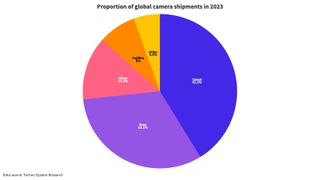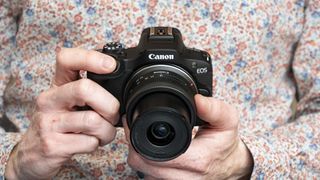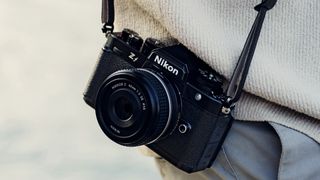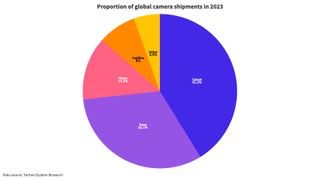Nikon, Sony, Fujifilm and Panasonic may have given us the best mirrorless cameras of 2023, but a comparatively modest year for Canon didn’t stop it from grabbing the largest global market share of cameras last year, according to a new report.
According to recently published market data from Nikkei and Statista, Canon still comfortably comes out on top on all key metrics, including market share and sales volume, for both mirrorless cameras and digital cameras as a whole.
The Nikkei report (via Sony Alpha Rumors) says that the global mirrorless camera market share in 2023 was divided like the pie chart below, with Canon taking 41.2% of shipments and Sony not too far behind on 31.2%. Nikon and Fujifilm took 8% and 5.5% respectively.

In another report by Statista that covers the market share by sales volume of the leading digital camera manufacturers worldwide (as of December 2023), the numbers differ but the positions remain the same and are even more heavily skewed in Canon’s favor.
In that report, Canon takes a 46.5% market share, compared to 26.1% for Sony and only 11.7% and 5.8% respectively for Nikon and Fujifilm. This is all during a year when Canon only gave us three low-cost models: the EOS R8, EOS R50 and EOS R100, plus the Powershot V10 which is a new vlogging camera. We also even labelled the EOS R100 as the worst camera of the year.
Canon was already the biggest name of the leading camera manufacturers, but the percentage of its market share in 2023 still feels surprising. So what are we to make of these numbers?

Is innovation enough?
In the TechRadar Choice Awards 2023, we awarded the Sony A7R V as the best mirrorless camera for pros, the Fujifilm X-S20 as the best for beginners, and the Panasonic Lumix S5 II as best for video, with an honorable mention to the Nikon Z8. There wasn’t a Canon camera in sight. However, this hasn’t dissuaded shoppers, according to market share data.
Other brands like Sony and Nikon won the tech battle in 2023, delivering innovations such as the Sony A9 III with the first global shutter in a mirrorless camera. And Nikon experienced a positive upturn in sales following the Z8, and it hopes to further bolster its market share after the acquisition of RED cameras.
However, none of this stopped Canon’s dominance of the market in 2023, which could further improve in 2024 now the EOS R5 Mark II and EOS R1 have been announced. (Although Fujifilm might have something to say about that with its wildly popular X100VI, assuming it can ship enough of them).
If Canon wasn’t impressing the industry with tech innovation in 2023, why is it still taking the lion share of the market? Beyond it being the leading name and any loyal customer base (and the fact that 2023’s market share isn’t only made up of cameras launched in 2023), I believe a factor is that it was the only one of the top three brands launching low-cost models.

Nikon delivered the Z8 and Zf, both superb full-frame cameras that costs thousands, while from Sony we got the likes of the ZV-E1, A7CR and A9 III – again costly full-frame models for pros.
At the same time, Canon launched its cheapest ever mirrorless camera, the EOS R100, plus a super affordable full-frame camera, the EOS R8. These cameras didn’t excite, but perhaps they were the smartest business moves of all. Meanwhile, Fujifilm gave us a range of models in 2023 at all price points, but limits the number of units it produces.
While many assume the low-end of the camera market has been decimated by smartphones, perhaps there’s still life in the best cheap cameras yet. I’d like to see Nikon and Sony give more options for beginners – they’ve both neglected that part of the market recently. Doing so might shake up the market even more.
You might also like
Services Marketplace – Listings, Bookings & Reviews
